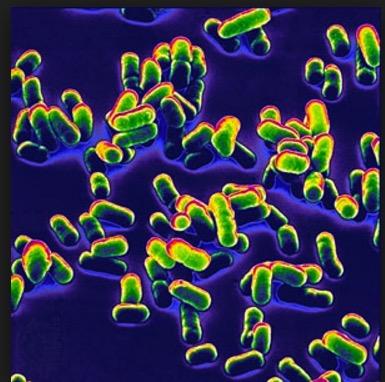
Bacteria are living infectious microbes that exist in the environment independent of hosts, although some clearly exist in host organisms (the gut microbiome). Some of the truly massive plagues in human history were bacterial in origin. These bacteria include anthrax, TB, cholera, Yersinia (bubonic - pneumonic plague), typhus, syphilis (a gift from the new world native peoples), gonorrhea, tetanus, salmonella, Lyme disease, C. difficile, Legionnaires’ disease, typhoid fever, leprosy, rheumatic disease and various forms of bacterial pneumonia and meningitis. As can be seen from the two lists below, bacterial organisms were the major diseases killing us in 1850. By 1900, sanitation had changed that list considerably, but bacterial infections were still the top three killers prior to the introduction of those wonder drugs, the antibiotics, starting in 1905 with the release of the anti-syphilis drug Salvarsan. Salvarsan, an obnoxious organoarsenic-based drug, was a miracle drug in its time but ultimately was replaced by penicillin and other safer antibiotics. However, Salvarsan may rise yet again when syphilis becomes resistant to all those new antibacterial drugs.
Leading causes of death in 1850 America
- Tuberculosis
- Dysentery
- Cholera
- Malaria (a parasite not a bacteria)
- Typhoid fever
- Pneumonia (including influenza)
- Diphtheria
- Scarlet fever (Staphylococci)
- Meningitis
- Whooping cough
(Accidents and violence seem to be conspicuous by their absence on a leading cause of death list from that era)
Leading causes of death in 1900 America
Pneumonia (including influenza)
- Tuberculosis
- Diarrhea
- Heart disease
- Stroke
- Liver disease
- Accidents
- Cancer
- “Normal aging”
- Diphtheria
None of these infectious diseases, except pneumonia appear on today’s list of top 10 killers, and it ranks #8 with viral influenza included. Antibiotics discovered in the 20th century vanquished bacterial infections from our list of killers at least in the developed world. Many of our modern practices in medicine are highly dependent on the availability of effective antibacterial drugs. These include the use of immunosuppressant drugs for autoimmune disease control, use of chemotherapy in oncology, organ transplant, and a multitude of surgical procedures including joint replacements. In fact, virtually all invasive medical procedures are dependent on the accessibility of efficacious antibacterial drugs as are the use of indwelling devices like ports, artificial joints and colostomy outlets. Without effective antibiotics, the risk of infection is just too high for certain medical procedures and practices.
Chemotherapy, transplants, C-sections and joint replacements could become too dangerous to perform. Starting in the 1930s, diseases plaguing humans could be managed and even cured with antibiotics including skin infections, infections in severe burns, bowel surgery, sexually transmitted infections, bacterial dysentery, necrotizing fasciitis, stomach ulcers, wound infections, gangrene, diabetic skin ulcers and the highly lethal pneumonias, just to name a few. No longer did people routinely die from a simple finger cut while gardening that subsequently became infected or a cold that advanced to bacterial pneumonia. Unfortunately, all this success is in the process of reversing direction as we return to the pre-antibiotic era.
Bacteria are ubiquitous in the world around us. There are approximately 5×1030 bacteria on Earth. They inhabit every corner of the earth, including every surface we contact, our gardens, our companion animals, our food and our loved ones. They colonize the surface of our skin, our nose and mouth, our gut and the tissues of our organs. Some are pathogenic, others are benign and still others can be both. Our immune system tries to control these bugs but depending on the ever-evolving (of the Darwinian type) status of bacteria, today’s uninteresting creatures can become tomorrow’s plague.
Bacteria come in two flavors, the Gram-positive and Gram-negative subtypes which are based on the specific membrane structure surrounding the bacterium. Each type presents its own special issues for treatment. Bacteria can thrive in an anaerobic environment and others require exposure to an oxygen environment. Bacteria can be found in the deepest sea muds, the polar ice caps and the waters of thermal hot springs. Some produce extremely potent toxins that are responsible for their clinical manifestations and are a threat to patient survival. Vaccines targeting these toxins prevent bacterial mayhem arising from the toxins (i.e., tetanus and diphtheria antitoxin vaccines). There are a very limited number of vaccines addressing bacterial diseases including typhoid, cholera, pneumococcal bacteria, Neisseria meningitidis, Haemophilus influenzae type B and anthrax (for livestock and for emergency use in humans exposed during a biological attach).
Needless to say, this is a vast field of study. I will not continue to elaborate, because this section would become a life’s work. The topic is emerging future plagues. With bacteria so well controlled by antibacterial drugs, is this an issue with this type of infectious agent? The answer is yes. It is not the same type of problem described for viruses, but rather the relentless loss of effective control of bacterial infection due to the rise of bacterial drug resistance and subsequent obsolescence of antibiotic drug therapy.
We do encounter newly emerging bacteria like Lyme disease and Legionnaires’ disease, but these can respond to our current antibacterial drugs. Unfortunately, we do not pay much attention to certain neglected bacterial plagues like trachoma that causes blindness and affects 63 million people around the world. However, for us, it is the re-emerging bacteria resistant to our life saving antibiotic drugs, that will return us to the era when Pneumonia, TB and dysentery headed the list of causes of death. An interesting re-emerging zoonotic bacteria is Bartonella or better knownby its WW1 moniker, trench foot. Its native hosts are rodents, but it has jumped into a number of mammalian species, including cats and dogs, where it continues to percolate. Bartonella can be transmitted by a multitude of arthropods, most notable body lice and fleas. In humans, it causes massive hemolytic anemia, skin lesions, endocarditis and trench fever.



